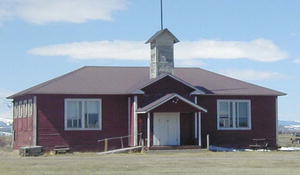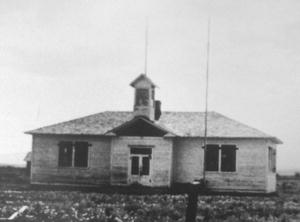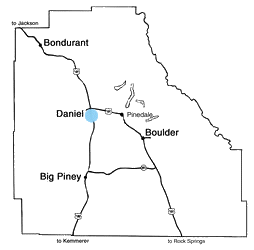Daniel School House
Daniel, Wyoming
The Daniel School was constructed in 1920 by A.F. Atwood, General Contractor
and Builder, from Big Piney, Wyoming. It is located on the western end
of the small town of Daniel, on a level plain between the Green River
to the north and Horse Creek to the south. This is an area rich in history,
the location of several of the historic Green River Rendezvous that
took place in the early 1800s.
At the time the school was built, the county was sprinkled with a small
number of large ranches spread out over large areas. Providing the children
of Sublette County an education presented a unique challenge due to
the poor transportation and long winters. As a solution, numerous one-room
schools were created to serve a few nearby ranches. Classes were often
held in bunkhouses or other adapted buildings, or in small one-room
log schools that could be easily moved from one location to another
as needed. As the region became more settled and the towns began to
grow in population early in the 20th century, more substantial permanent
school buildings were built to replace the early log or frame one-room
schools. Larger schools were built at Big Piney, Pinedale (the county
seat), and in the smaller communities of Boulder, Calpet and Daniel.
The Daniel school is representative of this second stage of educational
development in the region. Although a modest facility, it represented
a substantial physical improvement over the one-room log school that
it replaced.
 |
|
Daniel Community Center
in 2001.
|
The School is a large, wood frame, one-story building, 28' x 56'. With building
materials from the Big Piney Lumber and Supply Company, the construction
was finished in October. It appears to have been built from an architectural
plan book provided by the school district, and the local contractor constructed
the building to these specifications. The standard school plan is reflected
in the high ceilings and relatively large floor space, a cloakroom, and
large multi-paned banks of windows set high in the walls of opposite elevations.
Although Daniel had a population of less than 100 people in 1920, the
School Board of Directors advertised for sealed bids in the Big Piney
Examiner for the construction of a new school at Daniel in July
1920. The board members were E.D. Key, C.F. Webb and Harold Munn. The
advertisement called for the building of a frame schoolhouse measuring
28 x 56 feet with two rooms, a shingled roof, lathed and plastered on
the interior, a brick chimney, and a cement foundation. The announcement
also stated that the plans could be seen by prospective bidders at E.D.
Key's store in Daniel. The Daniel community wholeheartedly backed the
building of the new school. A box supper was held in September, and
a large sum of money was raised to purchase desks for the school, still
under construction.
In the school year of 1921-1922 a musical party was held at the school
in March in order to raise money to pay for what was still owed on a
piano bought for the school. The orchestra, directed by Daniel storekeeper
Elwood W. Albert, had a piano, trombone, comb, coronet, drum, flute,
and cymbals. Activities in other years included a birdhouse contest,
spelling contests, dances, track meets, a health club, art programs,
and school plays and singing programs. Courses taught included arithmetic,
reading, penmanship, spelling, poems, short story writing, vocal music,
and musical instrument,. Athletic sports included broad jump, high jump,
50 & 100 yard dash, shot put, pole vault, and potato races.
During the school year of 1929-1930, the school teacher for the Daniel
School was Miss Madge McHugh, who had taught in Sublette County for
several years. School began on September 9 and there were eleven pupils
enrolled. Madge boarded with Mr. E. D. Key and his daughter, Beulah,
at the beginning of the school year, then later moved to the Sargeant's
Inn. At Christmas time, she went back home to Wisconsin to visit. When
she returned, Sargeant's Inn had closed, so she spent the rest of the
school yeaar at the Joseph Huston home. To begin the school year, Madge
took the children on a wiener and marshmallow roast in the willows along
Prairie Creek. Madge later married Jack Funk in Salt Lake City, Utah
in 1941. She lived the rest of her life in Pinedale where she became
almost legendary contributing her boundless energy to community events
and activities that involved children. Madge's small log cabin was located
just off Pine Street and north Tyler, behind Moosely Books until she
died. The cabin is now located on the grounds of the Museum of the Mountain
Man.
During the school years of 1927-1928 and 1931-1932, school children
in Daniel was taught by Mary Scott. After coming to the Sublette County
area as an early teacher, she married pioneer rancher Harve Scott in
1912. His death in 1940 ended her teaching career, and she went on to
become a Wyoming historian with a special interest for the Oregon Trail
and authored a book entitiled, The Oregon Trail. She died in
1961 and is buried in Pinedale.
The Daniel School was one of only four rural schools in Sublette County
to meet state requirements for standard schools (Big Piney and Pinedale
also met the requirements, but were considered urban schools.) In 1938,
Jerome Deveraux, superintendent of District Nine Schools in and around
Big Piney, conducted a survey of rural schools in Sublette County for
his Master's thesis from the University of Wyoming using statistics
gathered in 1936. At that time, the Daniel School and its equipment
scored 275 out of a possible 475 points on an official score sheet for
rural schools. It ranked only second to Calpet in total points for rural
school buildings and equipment. At the time of the survey, the Daniel
School had twenty pupils' desks, two teachers' desks, blackboards, a
library, a coal stove for heat, individual drinking cups for water,
artificial lights, and swings and seesaws in a fenced playground. The
building had an estimated value of $1500, $100 worth of furniture, and
$250 worth of books. Although these attributes seem quite modest, many
of them were absent from most of the rural schools of Sublette County,
even at this late date. The typical pupil outside of Big Piney and Pinedale
still attended a one-room log school building with less than 12 students.
During the 1920s and early 1930s, it appears that only grades one through
eight were taught. In the late 1930s, grades nine and ten were added.
Consolidation brought an end to the Daniel School. Daniel had been
a part of District No. 8. This was the first school district to be eliminated
in the earliest serious attempt at consolidation in Sublette County.
Starting with the 1939-1940 school year, District No. 8 was incorporated
into District No. 1, and Daniel pupils were transported to Pinedale
for classes. The Daniel School stood abandoned for years until the Daniel
Homemaker Club, or Daniel Do Mores, acquired it. This community organization
repaired and remodeled the building.
The interior of the Daniel School was divided into two rooms by a moveable
partition and was easily converted to one large room for social functions.
The building is situated facing east on a concrete foundation. It has
a medium hip roof with a boxed cornice and is surfaced with wood shingles.
The exterior walls are covered with narrow clapboard siding and cornerboards.
There is a shallow gable-roofed closed porch centered in the east with
twin wood paneled doors that form the main entrance. The closed porch
once enclosed the cloakroom where the students hung their coats and
stored their lunches. There is a tall rectangular bell tower with wood
louvres and capped with a wood spire centered over the closed porch
and entrance. The bell is still in place in the bell tower.
There are two separate wood frame outhouses, each 4.7' square, for
boys and girls located about fifteen feet west of the southwest corner
of the school. Each has a gable roof covered with tarpaper and clapboard
siding and cornerboards. A well with the original hand pump also remains
on a raised platform on the east side of the school.
A gable-roofed open porch was added to the east side of the closed
porch sometime after 1973. This is the only significant exterior alteration
from the original design. The roof of the open porch is surfaced with
wood shingles and is supported with thin square wooden columns. It has
a wood deck, and a single concrete step leads to the deck level. The
school originally had wood frame rectangular six over six-light double-hung
windows. The window openings remain the same, but the windows have been
changed to accommodate fixed units with large plate glass lights and
aluminum frames.
The building was used as the Daniel school from 1920 to 1939 when the
School District #8 (Daniel) was combined with School District #1 (Pinedale)
and the students were bused to Pinedale. In 1956, the building was deeded
to the Daniel Homemaker's Club and is now owned by the Daniel Community
Center. It was placed on the National Register of Historic Places in
1990.
The structure has only had minor changes and looks much the same as
it did in 1920. An open extension was added to the original closed front
porch. Interior paneling and a lower false ceiling with new lights were
added in 1974. In the process, the north window were covered and the
south windows altered to accommodate kitchen cabinets. Finally, bathrooms
and a new bell were added in 2001. The original hardwood floor has been
retained along with some of the original trim and wooden baseboards.
A portion of the original blackboards remains on the west wall. The
schoolyard lot is not fenced and there is no playground equipment. Historic
photographs show that the Daniel School retains a high degree of physical
integrity and has received only minor exterior alterations. The building
was originally painted white. Currently, it is painted dark red with
white trim.
Today, the nearest buildings are residences over two hundred feet to
the south and four hundred feet to the north. The land to the west is
fenced as pasture and hay meadows, affording an unobstructed view of
the distant snow-covered peaks of the Wyoming and Gros Ventre mountain
ranges. The northern portion of the Wind River mountain range is also
clearly visible to the north and northeast. The site is treeless with
sagebrush growing in untended areas on the perimeters of the schoolyard.
Thick growths of willow bushes line the banks of Prairie Creek to the
north. The School is located approximately 1,000 feet west of US Hwy
189, the principal route that also forms the main street of Daniel.
The Daniel School is used today for many community events and activities
including wedding receptions, elections, and funeral receptions. At
least one Pinedale elementary teacher used to take her students on field
trips to the Daniel School and hold classes there to give them a one-room
school experience of a bygone era. The Aniel Daniel Chili Cookoff, first
held at the Green River Bar in 1982, is now held the first weekend in
April at the Daniel School. The Old Timers' Picnic, first held at the
David Ranch in 1980, is now held the third Sunday in July each year
at the Daniel School.
Teachers at the Daniel School
1922-1924 Angela O'Malia
1924-1925 Harold Parker
1925-1926 Etha Faler, Emma Bailey, Clara Hauer
1926-1927 Nellie Yates Ewer
1927-1928 Mary Scott
1928-1929 Clara Reid
1929-1930 Madge McHugh
1930-1931 L.L. Pape, Margaret McDole |
1931-1932 Mary Scott
1932-1933 Celia Sargent
1933-1934 Celia Sargent, Charlotte Schmidt
1934-1935 Albert Pellegrini, Charlotte Schmidt
1935-1936 Isabelle Norlander
1936-1937 Isabelle Norlander, Irene Wiggim
1937-1938 Kenneth Shaw, Georgia Fitzgerald
1938-1939 Kenneth Shaw, Florence Sommers,
Mary L. Sargent
|
Daniel School House maintained by
Daniel Community Center
PO Box 183, Daniel, WY 83115
|


